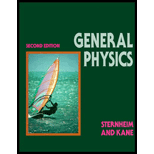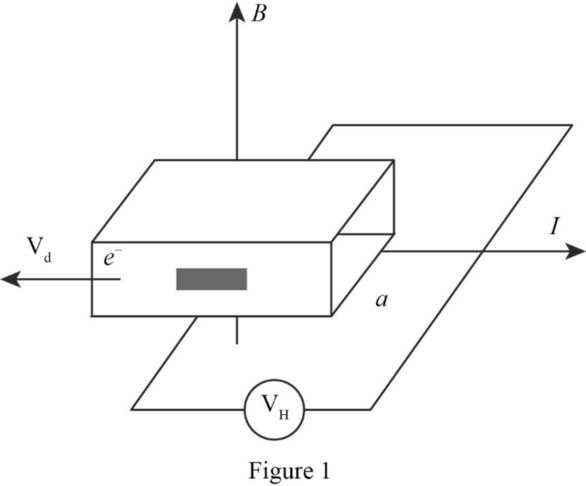
(a)
The magnitude and direction of the magnetic force on the electrons in the conductor shown in Figure 19.37.
(a)
Answer to Problem 33E
The magnitude of the force is
Explanation of Solution
The magnitude of magnetic force experienced on a moving charge can be written as,
Here,
Let
Conclusion:
Substitute
Direction of force will be in the direction of the cross product
Therefore, the magnitude of the force is
(b)
The magnitude and direction of the electric field that would exert an equal but opposite force on the electrons.
(b)
Answer to Problem 33E
The magnitude of electric field that would exert an equal but opposite force on the electrons is
Explanation of Solution
Write the expression to find the force on a charge in an electric field.
Here,
Rewrite equation (III) to find
For an electron,
Substitute equation (II) in part (a) in (V) to find
The direction of electric force will be same as that of the force. That is upward.
Conclusion:
Therefore, the magnitude of electric field that would exert an equal but opposite force on the electrons is
(c)
The potential difference across the conductor to produce the electric field.
(c)
Answer to Problem 33E
Potential difference across the conductor to produce the electric field is
Explanation of Solution
Write the expression to find the work done on a charge in a potential difference.
Here,
Write the expression to find the work done.
Here,
Substitute equations (III) and (VI) in (VII) to and solve for
Conclusion:
From part (a) it is found that the magnitude of electric field that would exert an equal but opposite force on the electrons is
Substitute
Therefore, potential difference across the conductor to produce the electric field is
(d)
The potential difference when no external electric field is applied.
(d)
Answer to Problem 33E
The potential difference when no external electric field is applied is
Explanation of Solution
The establishment of a potential difference across a conductor in a magnetic field is called Hall effect.
Write the expression to find the hall voltage.
Here,
Conclusion:
Substitute
Therefore, the potential difference when no external electric field is applied is
(e)
The Hall potential difference of the circuit.
(e)
Answer to Problem 33E
The Hall potential difference is
Explanation of Solution
The establishment of a potential difference across a conductor in a magnetic field is called Hall effect. Use equation (X) in part (d) to find the Hall potential difference.
Conclusion:
Substitute
Therefore, the Hall potential difference is
(f)
The direction of current in the circuit in Figure 19.37.
(f)
Answer to Problem 33E
The direction of the current is out of the page.
Explanation of Solution
Figure 1 represents the direction of the current in the circuit. Since the drift velocity of electrons is into the page the direction of current will be opposite to that. That is out of the page.

Conclusion:
Therefore, the direction of the current is out of the page.
(g)
To check whether the Hall potential difference be the same when the carriers are negative.
(g)
Answer to Problem 33E
The Hall potential difference will be opposite in sign for a given current direction.
Explanation of Solution
Hall Effect is a
Conclusion:
Therefore, the Hall potential difference will be opposite in sign for a given current direction.
Want to see more full solutions like this?
Chapter 19 Solutions
General Physics, 2nd Edition
- Rank the magnitudes of' the forces exerted on the following particles from largest to smallest. In your ranking, display any cases of equality, (a) an electron moving at 1 Mm/s perpendicular to a 1-mT magnetic field (b) an electron moving at 1 Mm/s parallel to a 1-mT magnetic field (c) an electron moving at 2 Mm/s perpendicular to a 1-mT magnetic field (d) a proton moving at 1 Mm/s perpendicular to a 1-mT magnetic field (e) a proton moving at 1 Mm/s at a 45 angle to a 1-mT magnetic fieldarrow_forwardRank the magnitudes of the following magnetic fields from largest to smallest, noting any cases of equality. (a) the field 2 cm away from a long, straight wire carrying a current of 3 A (b) the Held at the center of a flat, compact, circular coil, 2 cm in radius, with 10 turns, carrying a current of 0.3 A (c) the field at the center of a solenoid 2 cm in radius and 200 cm long, with 1 000 turns, carrying a current of 0.3 A (d) the field at the center of a long, straight, metal bar, 2 cm in radius, carrying a current of 300 (e) a field of 1 mTarrow_forwardA cosmic-ray proton in interstellar space has an energy of 10.0 MeV and executes a circular orbit having a radius equal to that of Mercury’s orbit around the Sun (5.80 × 1010 m). What is the magnetic field in that region of space?arrow_forward
- Consider the mass spectrometer shown schematically in Active Figure 22.12. The magnitude of the electric field between the plates of the velocity selector is 2.50 103 V/m, and the magnetic field in both the velocity selector and the deflection chamber has a magnitude of 0.035 0 T. Calculate the radius of the path for a singly charged ion having a mass m = 2.18 1026 kg.arrow_forwardWhat magnetic field is required in order to confine a proton moving with a speed of 4.0 × 106 m/s to a circular orbit of radius 10 cm?arrow_forwardA proton moving horizontally enters a region where a uniform magnetic field is directed perpendicular to the proton’s velocity as shown in Figure OQ22.4. After the proton enters the field, does it (a) deflect downward, with its speed remaining constant; (b) deflect upward, moving in a semicircular path with constant speed, and exit the field moving to the left; (c) continue to move in the horizontal direction with constant velocity; (d) move in a circular orbit and become trapped by the field; or (e) deflect out of the plane of the paper? Figure OQ22.4arrow_forward
- A proton moving in the plane of the page has a kinetic energy of 6.00 MeV. A magnetic field of magnitude H = 1.00 T is directed into the page. The proton enters the magnetic field with its velocity vector at an angle = 45.0 to the linear boundary of' the field as shown in Figure P29.80. (a) Find x, the distance from the point of entry to where the proton will leave the field. (b) Determine . the angle between the boundary and the protons velocity vector as it leaves the field.arrow_forwardA thin copper rod 1.00 m long has a mass of 50.0 g. What is the minimum current in the rod that would allow it to levitate above the ground in a magnetic field of magnitude 0.100 T? (a) 1.20 A (b) 2.40 A (c) 4.90 A (d) 9.80 A (e) none of those answersarrow_forwardA horizontal power line of length 58 m carries a current of 2.2 kA as shown in Figure P19.34. Earths magnetic field at this location has a magnitude equal to 5.0 105. T and makes an angle of 65 with the power line. Find the magnitude and direction of the magnetic force on the power line. Figure P19.34arrow_forward
- A wire 2.80 m in length carries a current of 5.00 A in a region where a uniform magnetic field has a magnitude of 0.390 T. Calculate the magnitude of the magnetic force on the wire assuming the angle between the magnetic field and the current is (a) 60.0, (b) 90.0, and (c) 120.arrow_forwardA cosmic-ray electron moves at 7.5 × 106 m/sinches perpendicular to Earth’s magnetic field at an altitude queer the field strength is 1.0 × 105T. What is the radius of the circular path the electron follows?arrow_forwardA mass spectrometer (Fig. 30.40, page 956) operates with a uniform magnetic field of 20.0 mT and an electric field of 4.00 103 V/m in the velocity selector. What is the radius of the semicircular path of a doubly ionized alpha particle (ma = 6.64 1027 kg)?arrow_forward
 Principles of Physics: A Calculus-Based TextPhysicsISBN:9781133104261Author:Raymond A. Serway, John W. JewettPublisher:Cengage Learning
Principles of Physics: A Calculus-Based TextPhysicsISBN:9781133104261Author:Raymond A. Serway, John W. JewettPublisher:Cengage Learning Physics for Scientists and Engineers, Technology ...PhysicsISBN:9781305116399Author:Raymond A. Serway, John W. JewettPublisher:Cengage Learning
Physics for Scientists and Engineers, Technology ...PhysicsISBN:9781305116399Author:Raymond A. Serway, John W. JewettPublisher:Cengage Learning Glencoe Physics: Principles and Problems, Student...PhysicsISBN:9780078807213Author:Paul W. ZitzewitzPublisher:Glencoe/McGraw-Hill
Glencoe Physics: Principles and Problems, Student...PhysicsISBN:9780078807213Author:Paul W. ZitzewitzPublisher:Glencoe/McGraw-Hill College PhysicsPhysicsISBN:9781285737027Author:Raymond A. Serway, Chris VuillePublisher:Cengage Learning
College PhysicsPhysicsISBN:9781285737027Author:Raymond A. Serway, Chris VuillePublisher:Cengage Learning College PhysicsPhysicsISBN:9781305952300Author:Raymond A. Serway, Chris VuillePublisher:Cengage Learning
College PhysicsPhysicsISBN:9781305952300Author:Raymond A. Serway, Chris VuillePublisher:Cengage Learning





